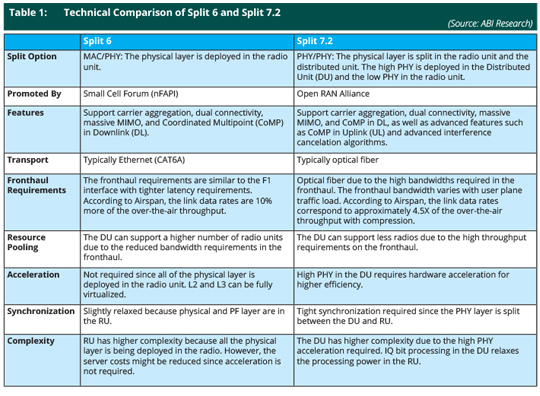The Potential of Open Radio Access Networks in In-Building Wireless
|
NEWS
|
In-building wireless solutions are becoming more attractive not only for the consumer market but also for enterprise digital transformation as 5G expands the boundaries from the consumer market to enterprise domain. Therefore, the cost of the cellular infrastructure and its associated capabilities should be flexible to enable Mobile Network Operators (MNOs), venue owners, and enterprises to select the best-of-breed equipment, reducing the Total Cost of Ownership (TCO) while meeting the coverage, capability, and capacity requirements of each specific use case. To date, Distributed Antenna Systems (DAS) and integrated small cells are well known in-building wireless solutions that effectively address coverage and capacity indoors. However, disaggregated small cell networks with open interfaces have the potential to make commercially viable the adoption of in-building wireless in medium and small multitenant buildings and enterprises, where DAS deployments could be expensive.
The 3rd Generation Partnership Project (3GPP) Release 15 standardized a split Radio Access Network (RAN) architecture for 5G, including Centralized Unit (CU), Distributed Units (DU), and Radio Unit (RU). These functional splits will reduce the burden on the high data rates in the fronthaul network, which are generated by the 5G traffic, mainly due to the expected high level of cell-site densification, wider spectrum bandwidths allocated to 5G, and advanced antenna technologies such as Active Antenna Systems (AAS) massive MIMO. In addition, RAN disaggregation breaks up the monolithic network approach to drive innovation and underpin a wider vendor ecosystem. Currently, there are different functional splits supported by the industry, particularly split 7.2, which has been adopted by the O-RAN Alliance (Open RAN fronthaul interface), and split 6, which is promoted by the Small Cell Forum (SCF) (nFAPI). These functional splits facilitate the deployment of disaggregated small cell networks (indoors and outdoors) with the potential of reducing the deployment cost. However, the choice of a functional split will ultimately depend on the fronthaul availability and the specific use case—particularly for an indoor wireless system—where there are specific requirements and consequences.
Comparison Between Split 6 and Split 7.2
|
IMPACT
|
The table below provides a technical comparison of split 6 and split 7.2; despite their main differences, split 6 and split 7.2 can benefit from centralized scheduling.

Chipset vendors such as Picocom, Radisys, and Qualcomm and network infrastructure vendors such as Airspan see great market opportunity for split 6 and split 7.2 in the indoor wireless domain.
Suitability of the Different Functional Splits for In-Building Wireless
|
RECOMMENDATIONS
|
Knowing the main differences between the functional splits studied in Table 1, ABI Research anticipates that MNOs and enterprise verticals will need to consider the tradeoffs between multiple factors when deploying disaggregated small cell networks as follows:
- Available infrastructure and whether new cabling is required (CAT6A and fiber)
- Cost associated to the RU and DU, which will be determined by the specific deployment and use case
- Complexity of the DU as well as resource pooling capabilities—the higher the throughput in the fronthaul link the less pooling capabilities are available, meaning that less RUs can be supported by the same DU
- Network performance—not all the use cases will require tighter interference mechanism or higher throughputs
- Future use cases should be contemplated to design the cellular coverage solution accordingly even if that represents a higher TCO
In indoor wireless deployments, multiple scenarios could be contemplated, thereby ABI Research provides the below examples, which are not exhaustive:
- In an enhanced Mobile Broadband (eMBB) scenario, the following options can be possible:
- If an MNO has access to fiber, split 7.2 might be a better option because the cost of the RU will be less compared to split 6 and additional features such as UL CoMP can be realized.
- If an MNO has to assume the costs of the fronthaul infrastructure, split 6 can be more cost effective because the cost of the transport is relatively low, the cost and resource pooling capabilities of the DU can be leveraged, and some CoMP capabilities can also be realized.
However, for complex indoor venues, where advanced interference cancellation algorithms are beneficial, split 7.2 could offer better spectral efficiency and provide end users with higher data throughputs:
- If the in-building wireless solution is required in the enterprise domain, the following options can be possible:
- If tighter interference mechanisms are required to increase reliability on the network, split 7.2 will enable the adoption of these advanced features as well as UL CoMP.
- If the solution is required for coverage and capacity only, as a corporate coverage solution, it is likely that split 6 will adjust better since the transport might be less expensive and advanced features such as UL CoMP will not be fully required. In addition, the cost of the RU in split 6 can become more competitive if the economies of scale apply.
ABI Research expects that there is not a straight answer as to what RAN functional split is better for indoor wireless because its adoption will ultimately depend on multiple factors such as the transport availability and specific use cases, as well as the supply chain and ecosystem behind each option. Therefore, it is likely that split 7.2 becomes largely adopted since there is a more advanced ecosystem due to the efforts of the O-RAN Alliance. However, ABI Research anticipates that both splits will likely coexist in the market in the indoor wireless domain.
